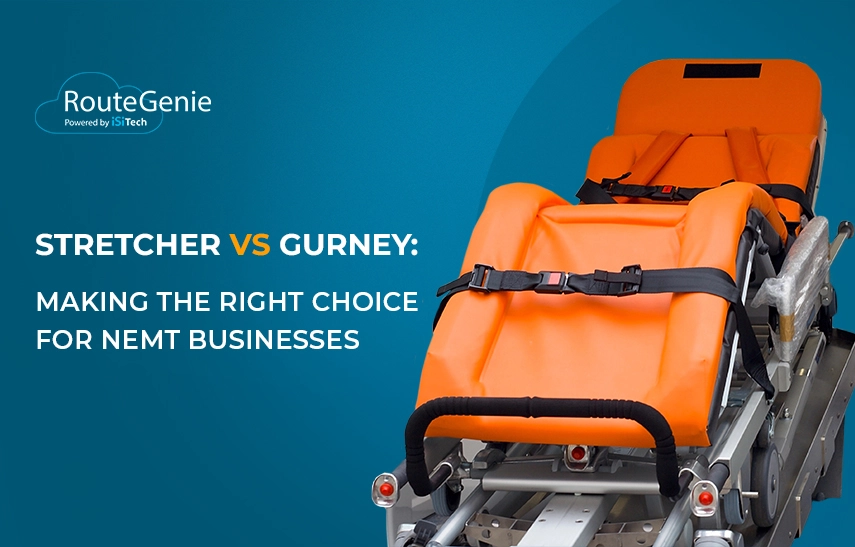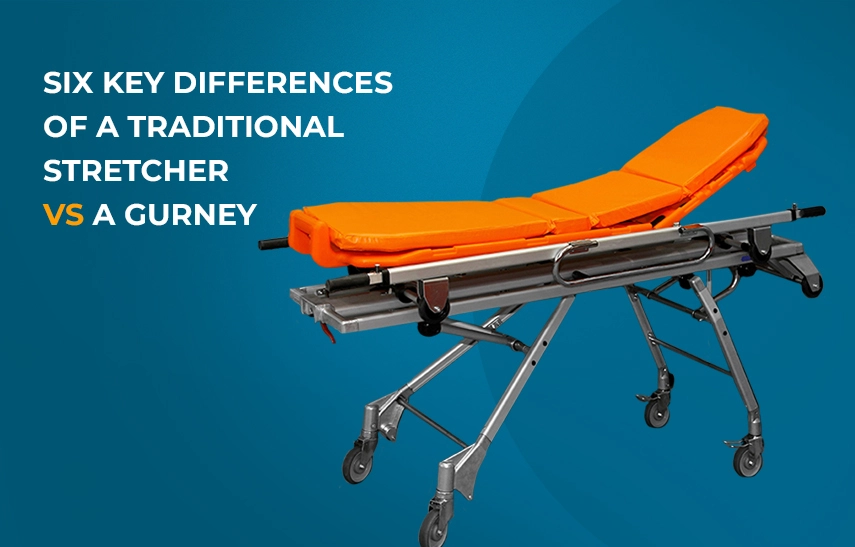How to Choose between Stretcher vs Gurney for NEMT

As an owner or manager of a non-emergency medical transportation (NEMT) company, you’ve probably wondered whether to use a stretcher vs gurney. Stretchers and gurneys are extremely useful. After all, they allow passengers in need of medical care to get on and off your vehicles quickly, especially if they face mobility challenges.
Since they technically serve the same purpose but to a different extent, which one should you choose?
In this article, we’ll explore the differences between stretchers and gurneys so you can make the right decision for your NEMT business.
Contents:
- Comparing Stretcher vs Gurney
- Six Key Differences of a Traditional Stretcher vs a Gurney
- Stretchers or Gurneys: Which Will You Choose?
Comparing Stretcher vs Gurney
Some people use the terms “stretchers” and “gurneys” interchangeably. However, they represent distinct types of medical equipment with dedicated uses. A gurney is a stretcher, but a stretcher is not a gurney. If you are an NEMT business owner making a list of equipment needed for your fleet, it is crucial to know their differences.
Every patient’s transportation needs are unique. For some, a simple wheelchair might be all they need to get from one place to another. But for those with severe mobility limitations, you need more specialized equipment.
Stretchers and gurneys are both convenient solutions for transporting passengers who cannot sit up or are otherwise bedridden. Deciding which one to use depends on the patient’s needs and the specific scenario in which the equipment will be used. Let’s take a closer look at stretchers and gurneys to better understand how each can be used by NEMT providers.
Stretcher Meaning
Since medieval times, stretchers have transported sick or wounded patients to medical care. In its most basic form, a stretcher is simply a litter-like platform comprised of two long pieces of wood, metal, or plastic and a fabric medium that can be used to carry a person.
Stretchers have a long history and have demonstrated centuries of staying power. The modern stretcher is a vast improvement on the basic fabric-and-poles design from hundreds of years ago. Today, stretchers are lightweight, portable, and durable. They are used in various settings, such as emergency rescues or sports injuries, and are carried by two or four people (at the corners).
Types of stretchers and their uses include:
- Portable stretchers - these are foldable and compact, often used for rescue operations in small spaces
- Basket stretchers - these are very sturdy and allow for vertical lifting (typically found on search and rescue missions, including air lifts)
- Stair chair stretchers - these can be used to carry patients down sets of stairs
- Ambulance (hospital) stretchers - these have big wheels for rugged terrain (gurneys)
Gurney Meaning
The gurney is an evolved form of the stretcher, adapted for modern ambulances and medical facilities. While stretchers have existed for centuries, gurneys only began being widely manufactured and used in the 1900s. A gurney is essentially a stretcher on wheels. While stretchers need to be carried by hand, gurneys can be wheeled along.
Gurneys are exceptionally useful medical equipment for patients who cannot move from their beds. Modern gurneys are almost like mobile beds, with features like adjustable headrests, support pads, and powered wheels. However, due to their size, gurneys can be difficult to fit into a vehicle unless it has been specially modified to accommodate them.
Six Key Differences of a Traditional Stretcher vs a Gurney
 A simple way to describe the difference between stretchers and gurneys would be that all gurneys are stretchers, but all stretchers are not gurneys. There are several key distinctions between gurneys and stretchers that NEMT providers should be aware of.
A simple way to describe the difference between stretchers and gurneys would be that all gurneys are stretchers, but all stretchers are not gurneys. There are several key distinctions between gurneys and stretchers that NEMT providers should be aware of.
1. Patient Condition
Your primary consideration when choosing between stretchers and gurneys should be the comfort of your passengers. Stretchers are fine for those with limited mobility and who can cooperate with an assistant while getting on the stretcher. Gurneys are required when dealing with patients who are completely unable to move or must remain completely flat.
2. Portability
Stretchers are more portable than gurneys. Some stretchers even have collapsible designs, making them easy to store when not in use. Meanwhile, gurneys usually have rigid or semi-collapsible frames, which means they take up more space in the vehicle.
3. Carrying Capacity
Stretchers are lightweight medical equipment, and their design prioritizes portability over robustness. This means that they may not be suitable for heavier patients. However, since gurneys usually have a fixed metal frame and can be fitted with additional support features, they can be used for patients of all sizes.
4. Number of Operators
Stretchers are usually carried by hand, which means they require at least two caregivers. But since a gurney is mounted on wheels, it can be moved along even by a single trained professional.
5. Ride Distance
A gurney is the better choice if a patient is going on a long journey. Stretchers are suitable for short trips where maneuverability in tight spaces could be a concern.
6. Cost
Because gurneys are more comfortable than stretchers and come with extra support and features, they are also more expensive.
Stretchers or Gurneys: Which Will You Choose?
Now that you know the features and uses of stretchers and gurneys, you can decide which type of medical equipment you need for your NEMT business. If you cater to a broad range of passengers, you can also outfit separate vehicles in your fleet with either a gurney or a stretcher.
Modern NEMT software solutions like RouteGenie help assign the right vehicle according to your passengers’ needs, allowing you to deliver the highest level of NEMT service.
Stretcher Transportation Questions Answered
What is the meaning of stretcher transport?
Stretcher transport refers to non-emergency medical transportation for individuals who must lie flat and cannot sit up during transit. It's typically used for patients with serious medical conditions but who don't require an ambulance.
How do you transport a patient on a stretcher?
A trained transport team secures the patient on a stretcher with safety straps, then loads it into a specially equipped vehicle where it’s locked in place. The patient is monitored throughout the ride to ensure safety and comfort.
How much does stretcher transportation cost?
The cost of stretcher transportation varies widely based on distance, location, and level of care needed. It typically ranges from $300 to over $1,000, and may be higher for long-distance trips. Insurance coverage also varies, so it’s best to check with your provider.
About the author

As RouteGenie's Marketing Director, Yurii gained deep knowledge in the NEMT industry. He is an expert in marketing, utilizing all marketing channels to build RouteGenie's brand and to make sure NEMT providers have access to powerful NEMT software that can boost their growth. Yurii shares his knowledge by writing content on topics related to marketing, and the healthcare industry: medical transportation, home care, and medical billing.
The author assumes no responsibility or liability for any errors or omissions in the content of this site. The information contained in this site is provided on an "as is" basis with no guarantees of completeness, accuracy, usefulness or timeliness.